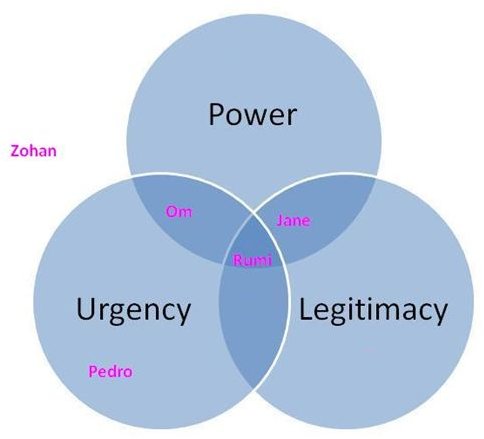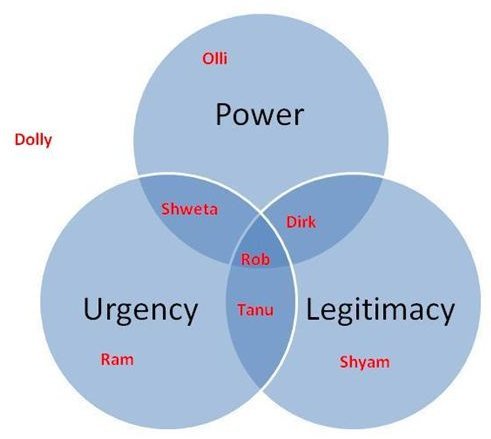Salience Model for Project Stakeholders Example
Introduction
The purpose of stakeholder analysis is to manage stakeholders more effectively. As part of Stakeholder Analysis, each stakeholder is classified based on parameters, such as Power and Influence (when you are using <strong>the Power/Influence grid</strong>), and Influence and Impact (when you are using <strong>the Influence/Impact grid</strong>). All these models use a two-dimensional approach to stakeholder classification.
In the Salience Model, three parameters are used classify stakeholders, instead of two. These parameters are: power, legitimacy, and urgency. By using these parameters, stakeholders are classified as Core, Dominant, Dependent, Dangerous, Latent, Demanding, Discretionary, and Non-stakeholders. Amongst these stakeholders, the Core, Dominant, Dependent, and Dangerous stakeholders require special attention. To understand the basics of the Salience Model and learn each type of stakeholder within this model, read the <strong>What is the Salience Model?</strong> article.
In the following example, let’s see if you can identify the stakeholders that require the most attention.
Example of Using the Salience Model for Project Stakeholders Management
Given the following Salience Model, which stakeholders are the Core, Dominant, Dependent, and Dangerous stakeholders?
In this Salience Model, the stakeholders classified as Core, Dominant, Dependent, and Dangerous are the ones that lie in the intersections of each major circle. In this example, the following information can be interpreted:
- Core: Rob
- Dominant: Dirk
- Dependent: Tanu
- Dangerous: Shweta
- Latent: Olli
- Demanding: Ram
- Discretionary: Shyam
- Non-stakeholders: Dolly
People that you should take special care of are: Rob, Dirk, Tanu, and Shweta. Avoid expending too much effort with non-stakeholders, like Dolly. Similarly, Ram may be the type that always wants their work to be prioritized and completed first. Ram’s work is probably not on <strong>the critical path</strong>, nor is it highly critical. Spending extended hours with Ram will probably not help your project gain mileage.
Examples of Each Stakeholder Type in the Salience Model
Stakeholders have certain behaviors and characteristics that can be extracted by asking questions or by observation. Sometimes during stakeholder analysis, you may not classify stakeholders. But, as the project progresses you can make the necessary changes as you learn more about each stakeholder.
Suppose you display the characteristics mentioned below with the following project stakeholders.
- Rumi: This person has power, expects immediate action on his queries and has significant involvement in the project.
- Jane: Her expectations need to be managed, but do not require immediate attention.
- Om: A senior project manager who has been brought into your project to seek expert judgment.
- Pedro: Demanding: people that always seem to think that their work needs your immediate attention
- Zohan: Someone you spend thirty minutes every day with from another department unrelated to the project.
Take a minute and try to classify each stakeholder into one of the eight classifications as described by the Salience Model for Project Stakeholders.

Your communication plan would be impacted by the classification of the stakeholders. Ensure you follow the basic principles of communications.
Screenshots by Rupen Sharma
